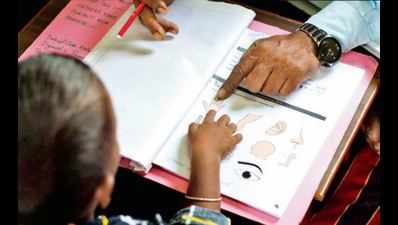- News
- City News
- bengaluru News
- They help parents learn to communicate with deaf kids
Trending
This story is from September 25, 2016
They help parents learn to communicate with deaf kids

Kids are taught basic maths, reading, writing and communication.
BENGALURU: Bright-eyed and boisterous, eight-year-old Bindu is a bundle of energy as she enters Vaani's Sadhan Resource Centre, which works with hearing impaired children and their families, in T Dasarahalli in West Bengaluru.As she communicates enthusiastically with her mother and teachers, the hearing aid clipped on is all but forgotten.
Started in 2005 in Assam, Vaani was founded to not just lend visibility to the problem of childhood deafness but also to include the parents of the disabled children in the process of teaching them to com municate.Children are taught basic mathematics, reading, writing and communication.Vaani has centres in Assam, Jharkand, Meghalaya, Mizoram, West Bengal and Karnataka and works with children aged 0 to 14 years.
Brinda Crishna, founder of Vaani, who has been working in the disability sector for 40 years, says early diagnosis is key to helping people adjust to disabilities. “For the last 200 years, deaf children were iso lated from parents and put in residential schools. These children grow up to be moody and emotionally immature adults as nobody worked on their social needs when they were young,“ she says.
Crishna says deafness is diagnosed only around age 6 or 7, until when the children are considered bratty and ill-behaved. It is this gap that Crishna and her team are attempting to fill by involving parents.The children visit the centre for an hour a week, and the centre offers services in tandem with special schools.
Vaani combines sign language, sounds and facial expressions to teach children to communicate. “We want the child to communicate in the manner they are most comfortable with,“ says Hemamalini.
Bindu's mother, Triveni has seen the impact of weekly sessions at Vaani. Now a community mobilizer for the organization, she says making par ents understand that their child's condition is nothing to be ashamed of is the biggest challenge. “Sometimes, we make more than 10 visits just to ensure that a child gets help.The first step making them accept their child's disability is the hardest,“ she says.
Another teacher Bhakti says being a teacher of the disabled needs infinitely more patience than a regular teacher.“Mainstream schools are illequipped to educate a deaf child, this is what parents need to understand. Even in special schools for the disabled, they learn only the theory of things.Here, we attempt to create a mental conception of everyday things, so that the child can communicate better,“ she says.
Started in 2005 in Assam, Vaani was founded to not just lend visibility to the problem of childhood deafness but also to include the parents of the disabled children in the process of teaching them to com municate.Children are taught basic mathematics, reading, writing and communication.Vaani has centres in Assam, Jharkand, Meghalaya, Mizoram, West Bengal and Karnataka and works with children aged 0 to 14 years.
Brinda Crishna, founder of Vaani, who has been working in the disability sector for 40 years, says early diagnosis is key to helping people adjust to disabilities. “For the last 200 years, deaf children were iso lated from parents and put in residential schools. These children grow up to be moody and emotionally immature adults as nobody worked on their social needs when they were young,“ she says.
Crishna says deafness is diagnosed only around age 6 or 7, until when the children are considered bratty and ill-behaved. It is this gap that Crishna and her team are attempting to fill by involving parents.The children visit the centre for an hour a week, and the centre offers services in tandem with special schools.
Hemamalini, a teacher who has been affiliated with the organization for two years, says parents should be actively involved in the learning and growth of their hearing-impaired children, as they spend the most time with them.“Most parents are in denial of their children's condition until it is too late. 81% of parents with a deaf child never learn to communicate with the child. This is why we have at least one parent in every session,“ she says.
Vaani combines sign language, sounds and facial expressions to teach children to communicate. “We want the child to communicate in the manner they are most comfortable with,“ says Hemamalini.
Bindu's mother, Triveni has seen the impact of weekly sessions at Vaani. Now a community mobilizer for the organization, she says making par ents understand that their child's condition is nothing to be ashamed of is the biggest challenge. “Sometimes, we make more than 10 visits just to ensure that a child gets help.The first step making them accept their child's disability is the hardest,“ she says.
Another teacher Bhakti says being a teacher of the disabled needs infinitely more patience than a regular teacher.“Mainstream schools are illequipped to educate a deaf child, this is what parents need to understand. Even in special schools for the disabled, they learn only the theory of things.Here, we attempt to create a mental conception of everyday things, so that the child can communicate better,“ she says.
End of Article
FOLLOW US ON SOCIAL MEDIA










